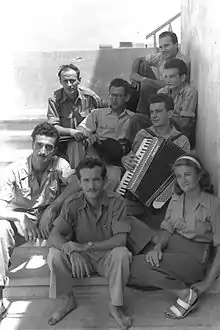Chizbatron
The Chizbatron (Hebrew: צ'יזבטרון) was an Israeli musical ensemble under the auspices of the Israel Defense Force (IDF). It operated during the 1948 Arab-Israeli War, serving within the Palmach.[1] In its existence, it was based out of Jaffa, to which they were often sent to the front line.

Overview
It was founded in January 1948, contributing to the Palmach in a cultural manner. One of the founders of the troupe was Haim Hefer, who served as its chief songwriter.[2] Hefer based the band off of Red Army military bands and song and dance ensembles, favoring the role they played during Second World War. The concept applied by entertainment units in the Yishuv were also drawn. This gave him the grounds to ask for permission from Palmach commander Yigal Alon for a budget of 10 British pounds to purchase accordions for means to establish such a band. Russian-born composer Sasha Argov was appointed as the first band director.[3] Its first performance was held on 2 February 1948 to training cadets in Dalia.[4] The band often toured by means of a truck or a jeep, and often performed on the front line in different battle conditions. The poem Hareut was originally performed by the troupe. In the summer of 1949 the band was dismantled by order of the IDF Education and Youth Corps.[5] The Chizbatron staged four productions during its existence, with a fifth being produced while it was a civilian theater.[6]
References
- "Ha'Chizbatron – 70 Years Stamp Sheet - Israel Post Shop". www.israelpost.co.il.
- Yudilovitch, Merav (14 November 2005). "Celebrating Haim Hefer's 80th birthday at Tzavta". Ynet (in Hebrew). Retrieved 17 October 2008.
- "Biography of Sasha Argov". web.nli.org.il.
- Almog, Oz (November 28, 2000). The Sabra: The Creation of the New Jew. University of California Press. ISBN 9780520216426 – via Google Books.
- "Subjects". palmach.org.il.
- "Ha'Chizbatron (Folk Music Group) (Israel 2018) | virtualstampclub.com".